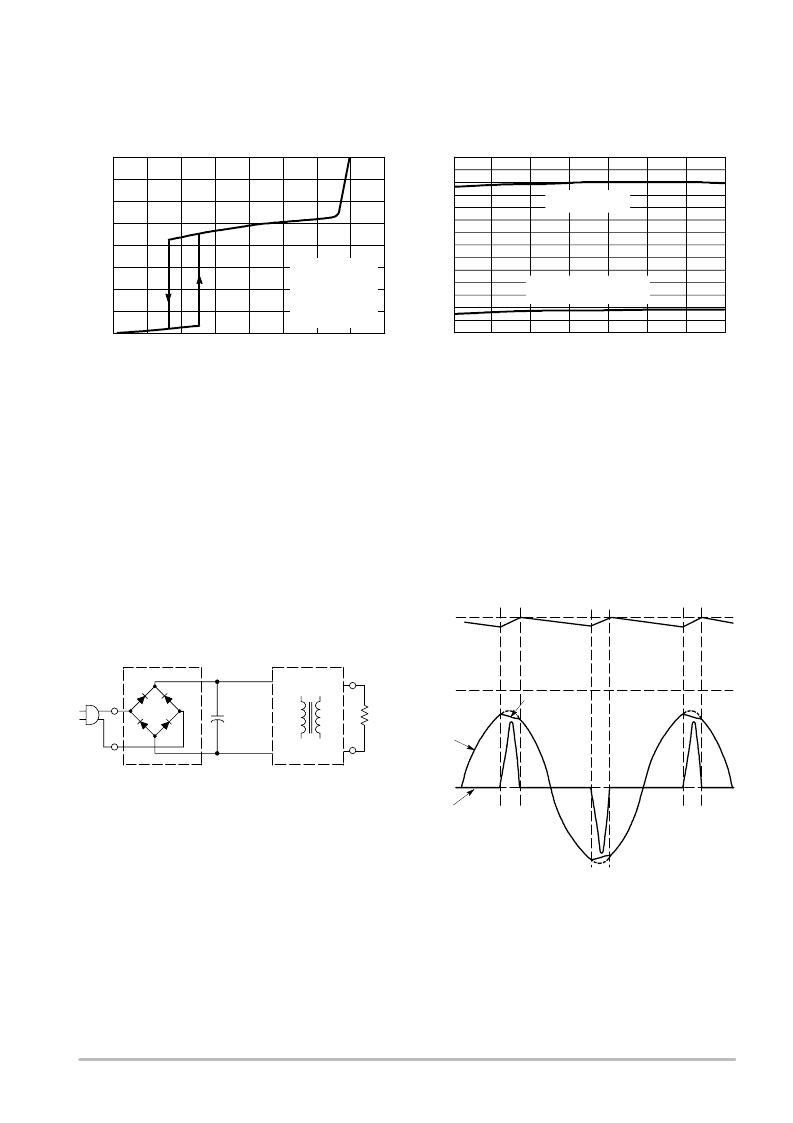- 您現(xiàn)在的位置:買賣IC網(wǎng) > PDF目錄385567 > MC33262CDR2 (ON SEMICONDUCTOR) Power Factor Controllers PDF資料下載
參數(shù)資料
| 型號: | MC33262CDR2 |
| 廠商: | ON SEMICONDUCTOR |
| 元件分類: | 穩(wěn)壓器 |
| 英文描述: | Power Factor Controllers |
| 中文描述: | 0.5 A POWER FACTOR CONTROLLER, PDSO8 |
| 封裝: | PLASTIC, SOIC-8 |
| 文件頁數(shù): | 6/19頁 |
| 文件大小: | 399K |
| 代理商: | MC33262CDR2 |

MC34262, MC33262
http://onsemi.com
6
IC
0
10
20
30
40
V
CC
, SUPPLY VOLTAGE (V)
V
FB
= 0 V
Current Sense = 0 V
Multiplier = 0 V
C
L
= 1.0 nF
f = 50 kHz
T
A
= 25
°
C
55
25
0
25
50
75
100
125
T
A
, AMBIENT TEMPERATURE (
°
C)
VC
Figure 14. Supply Current
versus Supply Voltage
Figure 15. Undervoltage Lockout Thresholds
versus Temperature
Startup Threshold
(V
CC
Increasing)
16
12
8.0
4.0
0
14
13
12
11
9.0
7.0
8.0
10
Minimum Operating Threshold
(V
CC
Decreasing)
FUNCTIONAL DESCRIPTION
Introduction
With the goal of exceeding the requirements of
legislation on linecurrent harmonic content, there is an
ever increasing demand for an economical method of
obtaining a unity power factor. This data sheet describes a
monolithic control IC that was specifically designed for
power factor control with minimal external components. It
offers the designer a simple, costeffective solution to
obtain the benefits of active power factor correction.
Most electronic ballasts and switching power supplies
use a bridge rectifier and a bulk storage capacitor to derive
raw dc voltage from the utility ac line, Figure 15.
Figure 16. Uncorrected Power Factor Circuit
AC
Line
Rectifiers
Converter
Bulk
Storage
Capacitor
+
Load
This simple rectifying circuit draws power from the line
when the instantaneous ac voltage exceeds the capacitor
voltage. This occurs near the line voltage peak and results
in a high charge current spike, Figure 16. Since power is
only taken near the line voltage peaks, the resulting spikes
of current are extremely nonsinusoidal with a high content
of harmonics. This results in a poor power factor condition
where the apparent input power is much higher than the real
power. Power factor ratios of 0.5 to 0.7 are common.
Power factor correction can be achieved with the use of
either a passive or an active input circuit. Passive circuits
usually contain a combination of large capacitors,
inductors, and rectifiers that operate at the ac line
frequency. Active circuits incorporate some form of a high
frequency switching converter for the power processing,
with the boost converter being the most popular topology,
Figure 17. Since active input circuits operate at a frequency
much higher than that of the ac line, they are smaller,
lighter in weight, and more efficient than a passive circuit
that yields similar results. With proper control of the
preconverter, almost any complex load can be made to
appear resistive to the ac line, thus significantly reducing
the harmonic current content.
Figure 17. Uncorrected Power Factor
Input Waveforms
V
pk
Rectified
DC
0
AC Line
Voltage
0
AC Line
Current
Line Sag
The MC34262, MC33262 are high performance, critical
conduction, currentmode power factor controllers
specifically designed for use in offline active
preconverters. These devices provide the necessary
features required to significantly enhance poor power
factor loads by keeping the ac line current sinusoidal and
in phase with the line voltage.
相關(guān)PDF資料 |
PDF描述 |
|---|---|
| MC33262CDR2G | Power Factor Controllers |
| MC33262DG | Power Factor Controllers |
| MC33262DR2 | Power Factor Controllers |
| MC33262DR2G | Power Factor Controllers |
| MC33262PG | Power Factor Controllers |
相關(guān)代理商/技術(shù)參數(shù) |
參數(shù)描述 |
|---|---|
| MC33262CDR2G | 功能描述:功率因數(shù)校正 IC ANA PFC W/OVERVOLT COMP RoHS:否 制造商:Fairchild Semiconductor 開關(guān)頻率:300 KHz 最大功率耗散: 最大工作溫度:+ 125 C 安裝風格:SMD/SMT 封裝 / 箱體:SOIC-8 封裝:Reel |
| MC33262D | 功能描述:功率因數(shù)校正 IC Critical Mode PFC RoHS:否 制造商:Fairchild Semiconductor 開關(guān)頻率:300 KHz 最大功率耗散: 最大工作溫度:+ 125 C 安裝風格:SMD/SMT 封裝 / 箱體:SOIC-8 封裝:Reel |
| MC33262DG | 功能描述:功率因數(shù)校正 IC Critical Mode PFC w/OVP RoHS:否 制造商:Fairchild Semiconductor 開關(guān)頻率:300 KHz 最大功率耗散: 最大工作溫度:+ 125 C 安裝風格:SMD/SMT 封裝 / 箱體:SOIC-8 封裝:Reel |
| MC33262DR2 | 功能描述:功率因數(shù)校正 IC Critical Mode PFC RoHS:否 制造商:Fairchild Semiconductor 開關(guān)頻率:300 KHz 最大功率耗散: 最大工作溫度:+ 125 C 安裝風格:SMD/SMT 封裝 / 箱體:SOIC-8 封裝:Reel |
| MC33262DR2G | 功能描述:功率因數(shù)校正 IC Critical Mode PFC w/OVP RoHS:否 制造商:Fairchild Semiconductor 開關(guān)頻率:300 KHz 最大功率耗散: 最大工作溫度:+ 125 C 安裝風格:SMD/SMT 封裝 / 箱體:SOIC-8 封裝:Reel |
發(fā)布緊急采購,3分鐘左右您將得到回復(fù)。